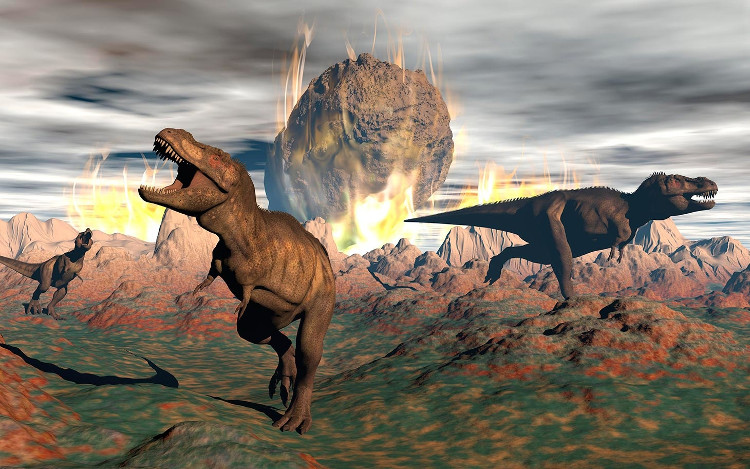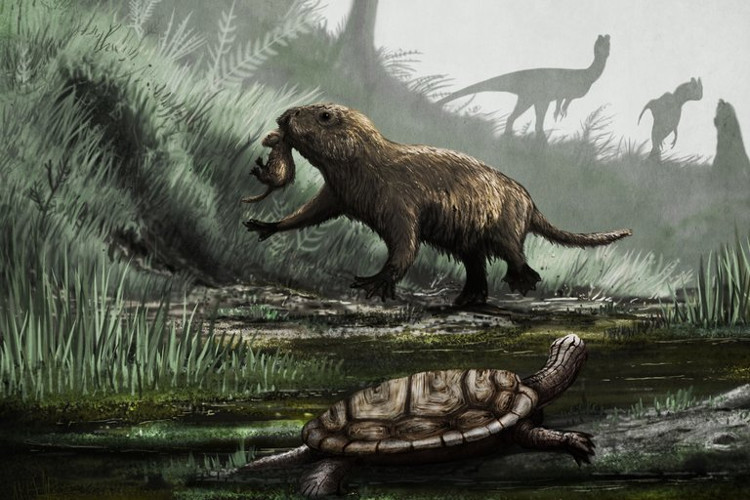People have nighttime sleeping habits thanks to ... extinct dinosaurs?
New research has shown that mammals are mostly night creatures until dinosaurs are destroyed by an asteroid about 66 million years ago.
This basic idea is based on the nocturnal bottleneck hypothesis hypothesis , which appeared in 1942. This hypothesis suggests that the species has been primarily active at night to avoid the risk of eating dinosaurs. meat, because these rulers mainly operate during the day.

The fact that asteroids hit Earth 66 million years ago made the dinosaurs extinct.(Artwork: Stocktrek Images).
A study described in the journal Nature Ecology & Evolution has recently shed light on a key transition in. The study offers a potential milestone that might have been in the past, and these furry creatures began to hide in the dark and stepped out into the light.
Researchers found that the first mammals that functioned day and night appeared about 65.8 million years ago, only 200,000 years after the event. Those first animals may have been the ancestors of even more clawed claws like modern birds, camels, hippos or even whales and dolphins.
Roi Maor, who is a graduate student at Tel Aviv University in Israel and University College London, and author of the article, said: 'In the course of evolution, 200,000 years is not a long time. , it's just like a tick. '

Mammals are mostly night creatures until dinosaurs are destroyed by an asteroid about 66 million years ago.(Photo: Mark Witton).
Scientists also found that animals that are active all day or only active during the day appear only about 52.4 million years ago (about 13 million years after the dinosaurs went extinct). One of them is monkeys, chimpanzees, ancestors of gorillas, gibbons and humans today.
However, Mr. Maor warns, his research only raises correlations, not the relationship between dinosaur extinction and the appearance of day-to-day animals. But this finding reinforces the hypothesis of how our ancestors dominated the day after dinosaurs disappeared.
Using computer software, Maor and his colleagues entered the live behavioral data of more than 2415 mammals. The data clearly indicates that they belong to the type of animals that operate during the day or at night, both day and night, and are less active both day and night. Computers will help analyze the relationship between ancestors of these animals.
'Think of it as an atlas, we show all the animals and their ancestors on the map. Our algorithm shows that the ancestors of animals today are active during the day or night , 'Maor said.
The map predicts the behavioral pattern of the ancestors of living animals at least 166 million years ago, during the Middle Age. It also underscores the transition from night activities to mammalian ancestral daytime activities after about 66 million years ago, when natural disasters occur on the planet.
Their dataset gathers organisms that represent 91% of mammals. In particular, nocturnal animals account for 60% such as bats, foxes, and porcupine porcupine porcupines; 26% are daytime animals like gray squirrels, giraffes and humans; most of the rest are animals that work all day and night like mole rats, European rabbits and musk rats.

The findings described in Nature Ecology & Evolution contribute to shedding light on the key transformation in the history of life on our planet.(Photo: Telegraph).
Lars Schmitz, an evolutionary biologist at Claremont College in California, who was not involved in the study, said he was happy to see a study that has such a large comparison. According to him, the conclusion of mammal research appears during the day to support the hypothesis of the "night bottleneck".
'This research supports the doctrine that people still talk about, that mammals usually only hide their activities at night and only switch to activities during the day when the dinosaur era is over , ' he said.
But he also pointed out the limitation of this study is that it only works on living organisms, not including extinct organisms. Without knowing the behavior of these extinct creatures, researchers could lose an important clue about the first occurrence of mammals.
- Sleep on the weekend - should it?
- What happens if humans and dinosaurs coexist?
- Elon Musk has a horrible sleeping habit, don't follow it!
- Frogs evolved by asteroids made dinosaurs extinct
- Decode 6 ugly habits of people
- Not a meteorite, what's really killing dinosaurs?
- 10 misconceptions about dinosaurs
- Fossils reveal information about life regeneration on Earth after extinct dinosaurs
- As long as meteors fall more than 30 seconds, dinosaurs are not extinct
- The cause of dinosaurs extinction
- Dangerous sleeping habits you may not know
- Not only because of meteors, the main reason for the extinction of dinosaurs was unexpected
 'Fine laughs' - Scary and painful torture in ancient times
'Fine laughs' - Scary and painful torture in ancient times The sequence of numbers 142857 of the Egyptian pyramids is known as the strangest number in the world - Why?
The sequence of numbers 142857 of the Egyptian pyramids is known as the strangest number in the world - Why? History of the iron
History of the iron What is alum?
What is alum? What would a day on the Moon be like for astronauts?
What would a day on the Moon be like for astronauts?  The human mind is not designed to stay awake past midnight.
The human mind is not designed to stay awake past midnight.  After 30 days of fasting and only drinking water, the human body changes to the point that one organ can be destroyed.
After 30 days of fasting and only drinking water, the human body changes to the point that one organ can be destroyed.  History and meaning of World Environment Day June 5
History and meaning of World Environment Day June 5  Admire the rare phenomenon 'day without shadow'
Admire the rare phenomenon 'day without shadow'  Tips to reduce stress in just 20 seconds a day
Tips to reduce stress in just 20 seconds a day 